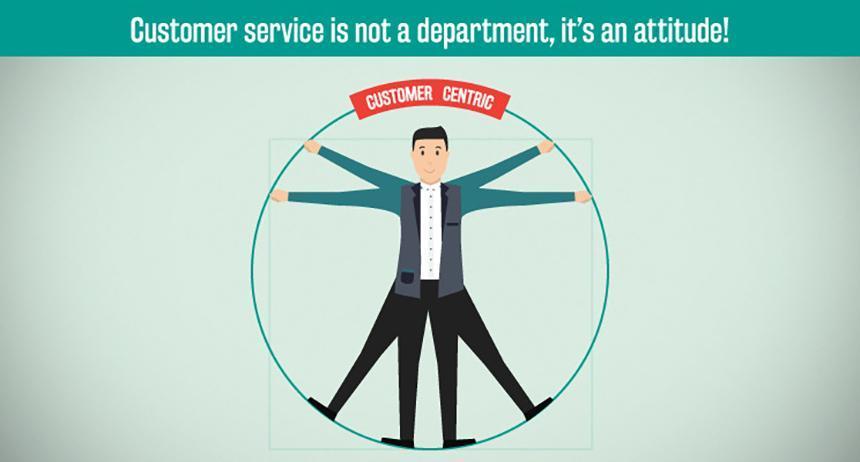By 2020, customer experience will overtake price and product as the key brand differentiator
Customer 2020 Report by Frost & Sullivan, 2015
Even 2020 seems too far away for this shift. Customer needs and wants are already placed as a top priority by social media and rapid technological evolution.
Amazon is a good example of customer-centric philosophy. Have you seen the video for Amazon Go?
If the technology mentioned in the video checks out, it seems as though Amazon has just raised the retail bar to enviable heights, viewed exclusively from a customer standpoint. And it was all done with one central question in mind – how to eliminate a longstanding pain point of wasting away your life in a checkout line?
There are numerous stories circulating about top CEOs, positive and negative. If anecdotal stories are true, one of the symbolic methods Jeff Bezos, Amazon’s CEO, uses in order to solidify the company’s customer ethos is to always leave one chair empty at a conference table – stating that the seat is occupied by the most important person in the room – the customer.
Where is procurement in this shift?
Procurement’s regular focus and tasks are traditionally ordering, sourcing, contracting and in simplified terms – providing the right goods/services at the right time in the right place for the right price. What if we replace all those roles with only one singular mission – to support organizational goals and objectives? Then we are on the right track on becoming a customer-centric procurement department. And the doors of product differentiation, cost competitiveness, expected quality, sustainability, agility, responsiveness and finally, satisfied customers are widely open to us.
Sounds great, how do we get there?
First of all, we have to define our customers. Procurement has internal and external customers. Usually procurement can only access the end customer through the intervention of internal customers. That’s why internal clients matter to procurement, because they hold the key to customer behavior. It is very important to keep that lifeline to internal clients healthy with a routine in place on how to understand customer needs and wants:
- Ask, do not make assumptions
- Try to understand not only „what“ but also „why“
- Extend your knowledge from supply market and suppliers to the knowledge on company’s environment, market, competition and consumer trends and habits
- Try to understand personal drives of each of your internal customer
- Act as an internal account manager, view internal customers as key accounts
- Be involved, involve yourself even if others do not involve you „by default“
What are the next steps?
- Make a clear vision about what procurement organization should be
- Ensure that everyone in procurement organization understands how their role is related to serving the external customers and all internal customers in-between
- Map and segment internal customers in a similar way you segment your suppliers by using a strategic stakeholder mapping tool
- Understand their sometimes conflicting requirements / interests
- Adjust procurement organization to be responsive – business partnering
- Identify and engage suppliers that are capable to bring required values by using a strategic supplier management tool
How do I measure progress?
- Set up a balanced procurement scorecard that would combine some traditional procurement KPIs (cost savings, cost avoidance…) with some business performance-related ones (revenue and profit measures, brand differentiation measures,…)
- Carry out half-year / annual internal customer satisfaction surveys
- Make regular exchanges and interviews with internal customers
- Use any other opportunity to get internal customers’ feedback
- Measure key suppliers’ satisfaction (are you a customer of choice?)
Lessons learned on customer-centric procurement
In our experience customer-centric procurement strategy starts with internal customers and suppliers. Internal customers are key because by fostering closer integration with customer-facing functions, procurement can get closer to customers themselves. And supplier relationship management is about customer satisfaction as much as leveraging spend potential. In addition, sometimes it is required to reorganize the supply chain in order to meet customer expectations, e.g. nearshoring to reduce lead time. In order to open the gates to customer-centricity, a combination of change management, initiatives, capability and recruiting needs to be implemented. And finally, additional costs for the organization are possible, but the return on investment is tremendous – increased overall customer satisfaction, better alignment with business goals, improved perception of procurement, differentiation from the competition, increased savings and profit.
Is procurement ready for this shift?
We can always say it depends on company’s subjective factors – company’s culture, history, maturity, business environment and competition, the level of strategic digitalization which decreases time to market, the influence of the CPO in the company and the strategic capabilities of the procurement team. The key is not to view customer-centricity as a short-term initiative, but a fundamental operating strategy. As the requirements change, so will the definition of procurement success. But we can also say that very soon that choice will be eliminated by market demands.
Ready or not, the shift is coming
The New Procurement Paradigm
Every company should serve the customer. A lot of them serve the product first, customer second. And procurement is in an interesting position where it has multiple customers – internal, suppliers, top management. And all those are just gatekeepers to the ultimate end customer. When we incorporate that big picture view into our day-to-day, then we can always remember to give our customer a seat at the table.
Written in collaboration with Danijel Banek, Executive Director of Central Purchasing at Atlantic Grupa and the recipient of EIPM Peter Kraljic Award for Procurement Organization of the Year in 2015
If you want to keep up with industry insights, be sure to follow Cirtuo’s LinkedIn page





